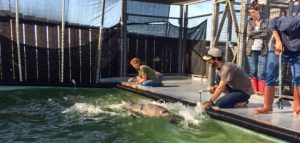Using accelerometers to detect feeding by California sea lions (in collaboration with Stefani Skrovan and Drs. Jen Zeligs and Peter Madsen, and under the guidance of Dr. Gitte McDonald)
 This project aims to develop a tagging and analysis method to reliably detect when California sea lions catch prey. California sea lions are abundant apex predators in the California current system and are well-studied, from diet, to studies of population and reproduction, to within-dive oxygen management physiology (see Gitte’s research!). However, logistical issues have thus far largely blocked any successful bids to truly pinpoint when California sea lions catch prey in wild settings (an issue that persists with most marine mammals, and especially otariids). The intent of this research is therefore to expand on the existing idea of using head-mounted accelerometry as a means to fill this knowledge gap, applying current datalogging capabilities and MATLAB analyses.
This project aims to develop a tagging and analysis method to reliably detect when California sea lions catch prey. California sea lions are abundant apex predators in the California current system and are well-studied, from diet, to studies of population and reproduction, to within-dive oxygen management physiology (see Gitte’s research!). However, logistical issues have thus far largely blocked any successful bids to truly pinpoint when California sea lions catch prey in wild settings (an issue that persists with most marine mammals, and especially otariids). The intent of this research is therefore to expand on the existing idea of using head-mounted accelerometry as a means to fill this knowledge gap, applying current datalogging capabilities and MATLAB analyses.
To do this, I am working with the sea lions, researchers, and trainers at SLEWTHS (Moss Landing, CA) to perform feeding trials in a simple, controlled environment. Two sea lions were trained to voluntarily participate in our experimental protocol, in which the sea lion is recorded on GoPro cameras as it travels across a pool, finds and consumes prey, and returns to the trainer – all while it wears a datalogger held snugly on its head by a neoprene strap custom-built (by yours truly) to fit well and avoid pain and discomfort. The datalogger (small, early version of the OpenTag datalogger by Loggehead Instruments) is set to sample triaxial acceleration (acceleration along the forward/backward, side-to-side, and up-and-down axes relative to the tag’s position in space) at 333Hz.
Analyses of these data are ongoing, as are “control” trials to mimic the swimming movements without the prey capture; however, even now preliminary results do seem to indicate that my in-depth, nitpicky MATLAB analysis of acceleration movements does a great job of detecting feeding while neglecting other movements.

